CHCECE003 Provide Care for Children Assessment - Short Questions
VerifiedAdded on 2023/03/30
|18
|3677
|132
Homework Assignment
AI Summary
This document provides a comprehensive set of solutions for the CHCECE003 Provide Care for Children assessment. It includes detailed answers to short questions covering topics such as creating a safe and stimulating environment, educator engagement during meal times, sun safety policies, and the National Quality Standard (NQS) 2.2.2 regarding physical activity. The document also addresses questions on the benefits of physical activity for children, planning activities, and the importance of schedules and routines. Additionally, it offers solutions to case studies, focusing on scenarios related to toileting accidents and separation anxiety, and provides insights into how educators can support children through transitions. The document also includes research activities and a reflective journal component.
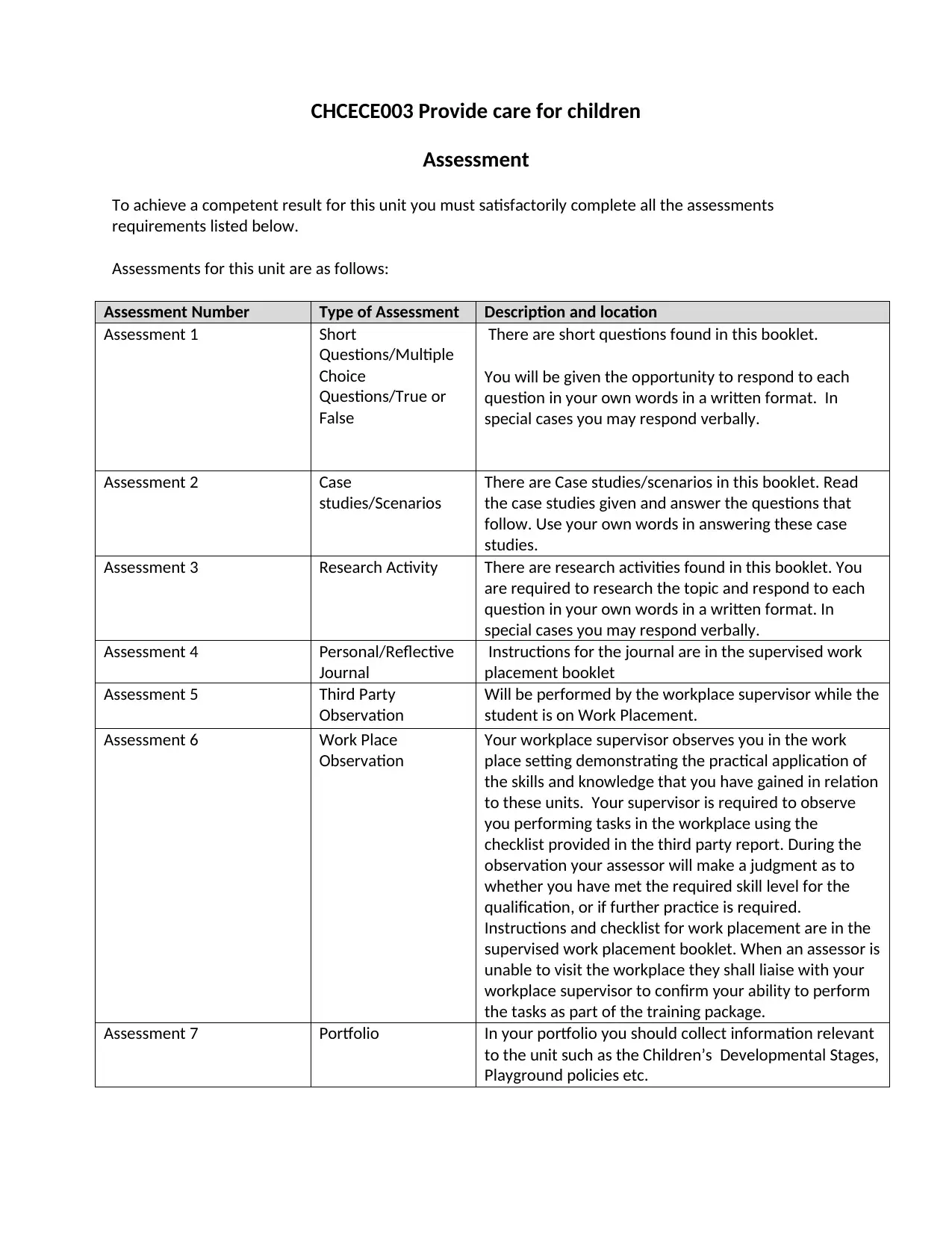
CHCECE003 Provide care for children
Assessment
To achieve a competent result for this unit you must satisfactorily complete all the assessments
requirements listed below.
Assessments for this unit are as follows:
Assessment Number Type of Assessment Description and location
Assessment 1 Short
Questions/Multiple
Choice
Questions/True or
False
There are short questions found in this booklet.
You will be given the opportunity to respond to each
question in your own words in a written format. In
special cases you may respond verbally.
Assessment 2 Case
studies/Scenarios
There are Case studies/scenarios in this booklet. Read
the case studies given and answer the questions that
follow. Use your own words in answering these case
studies.
Assessment 3 Research Activity There are research activities found in this booklet. You
are required to research the topic and respond to each
question in your own words in a written format. In
special cases you may respond verbally.
Assessment 4 Personal/Reflective
Journal
Instructions for the journal are in the supervised work
placement booklet
Assessment 5 Third Party
Observation
Will be performed by the workplace supervisor while the
student is on Work Placement.
Assessment 6 Work Place
Observation
Your workplace supervisor observes you in the work
place setting demonstrating the practical application of
the skills and knowledge that you have gained in relation
to these units. Your supervisor is required to observe
you performing tasks in the workplace using the
checklist provided in the third party report. During the
observation your assessor will make a judgment as to
whether you have met the required skill level for the
qualification, or if further practice is required.
Instructions and checklist for work placement are in the
supervised work placement booklet. When an assessor is
unable to visit the workplace they shall liaise with your
workplace supervisor to confirm your ability to perform
the tasks as part of the training package.
Assessment 7 Portfolio In your portfolio you should collect information relevant
to the unit such as the Children’s Developmental Stages,
Playground policies etc.
Assessment
To achieve a competent result for this unit you must satisfactorily complete all the assessments
requirements listed below.
Assessments for this unit are as follows:
Assessment Number Type of Assessment Description and location
Assessment 1 Short
Questions/Multiple
Choice
Questions/True or
False
There are short questions found in this booklet.
You will be given the opportunity to respond to each
question in your own words in a written format. In
special cases you may respond verbally.
Assessment 2 Case
studies/Scenarios
There are Case studies/scenarios in this booklet. Read
the case studies given and answer the questions that
follow. Use your own words in answering these case
studies.
Assessment 3 Research Activity There are research activities found in this booklet. You
are required to research the topic and respond to each
question in your own words in a written format. In
special cases you may respond verbally.
Assessment 4 Personal/Reflective
Journal
Instructions for the journal are in the supervised work
placement booklet
Assessment 5 Third Party
Observation
Will be performed by the workplace supervisor while the
student is on Work Placement.
Assessment 6 Work Place
Observation
Your workplace supervisor observes you in the work
place setting demonstrating the practical application of
the skills and knowledge that you have gained in relation
to these units. Your supervisor is required to observe
you performing tasks in the workplace using the
checklist provided in the third party report. During the
observation your assessor will make a judgment as to
whether you have met the required skill level for the
qualification, or if further practice is required.
Instructions and checklist for work placement are in the
supervised work placement booklet. When an assessor is
unable to visit the workplace they shall liaise with your
workplace supervisor to confirm your ability to perform
the tasks as part of the training package.
Assessment 7 Portfolio In your portfolio you should collect information relevant
to the unit such as the Children’s Developmental Stages,
Playground policies etc.
Paraphrase This Document
Need a fresh take? Get an instant paraphrase of this document with our AI Paraphraser
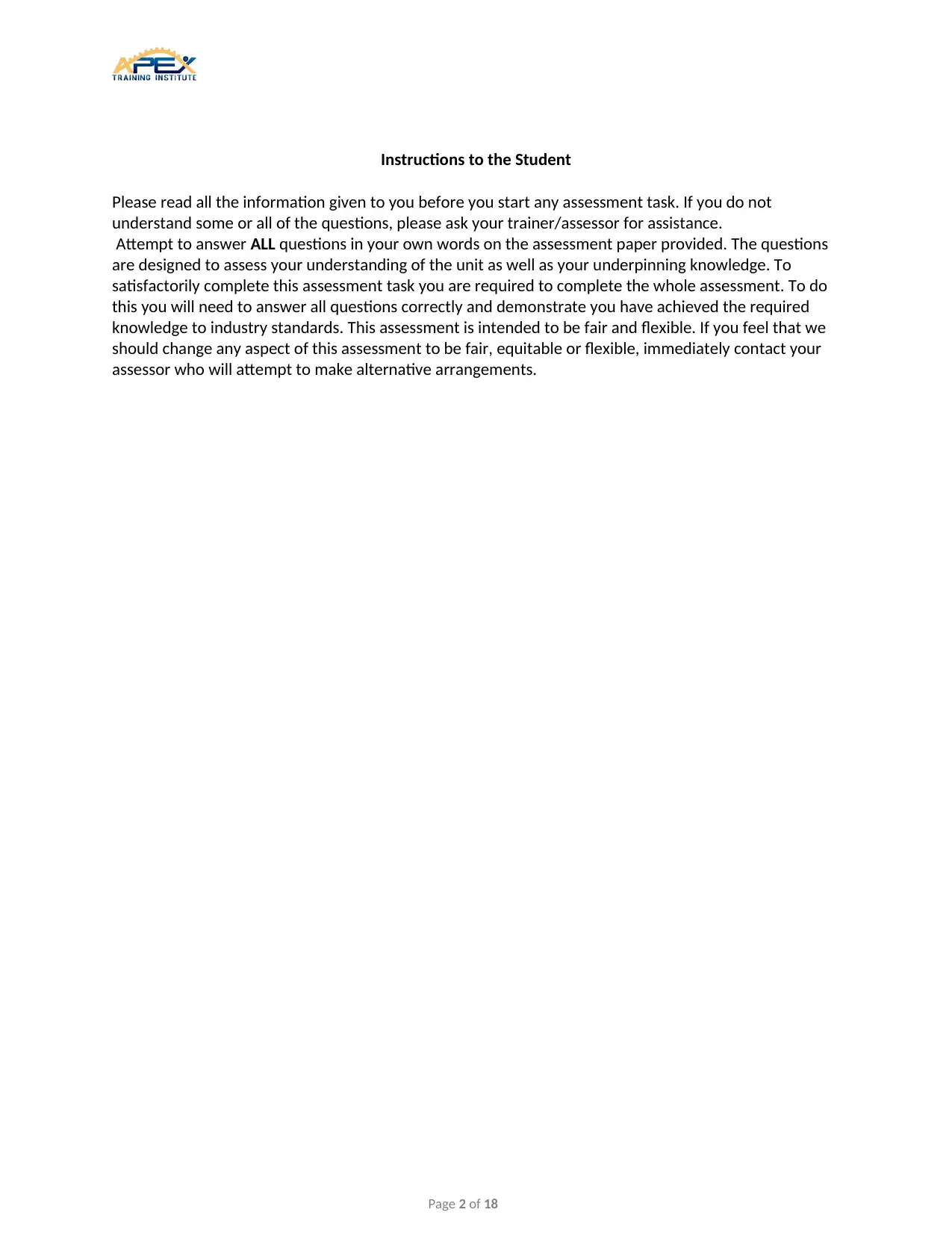
Instructions to the Student
Please read all the information given to you before you start any assessment task. If you do not
understand some or all of the questions, please ask your trainer/assessor for assistance.
Attempt to answer ALL questions in your own words on the assessment paper provided. The questions
are designed to assess your understanding of the unit as well as your underpinning knowledge. To
satisfactorily complete this assessment task you are required to complete the whole assessment. To do
this you will need to answer all questions correctly and demonstrate you have achieved the required
knowledge to industry standards. This assessment is intended to be fair and flexible. If you feel that we
should change any aspect of this assessment to be fair, equitable or flexible, immediately contact your
assessor who will attempt to make alternative arrangements.
Page 2 of 18
Please read all the information given to you before you start any assessment task. If you do not
understand some or all of the questions, please ask your trainer/assessor for assistance.
Attempt to answer ALL questions in your own words on the assessment paper provided. The questions
are designed to assess your understanding of the unit as well as your underpinning knowledge. To
satisfactorily complete this assessment task you are required to complete the whole assessment. To do
this you will need to answer all questions correctly and demonstrate you have achieved the required
knowledge to industry standards. This assessment is intended to be fair and flexible. If you feel that we
should change any aspect of this assessment to be fair, equitable or flexible, immediately contact your
assessor who will attempt to make alternative arrangements.
Page 2 of 18
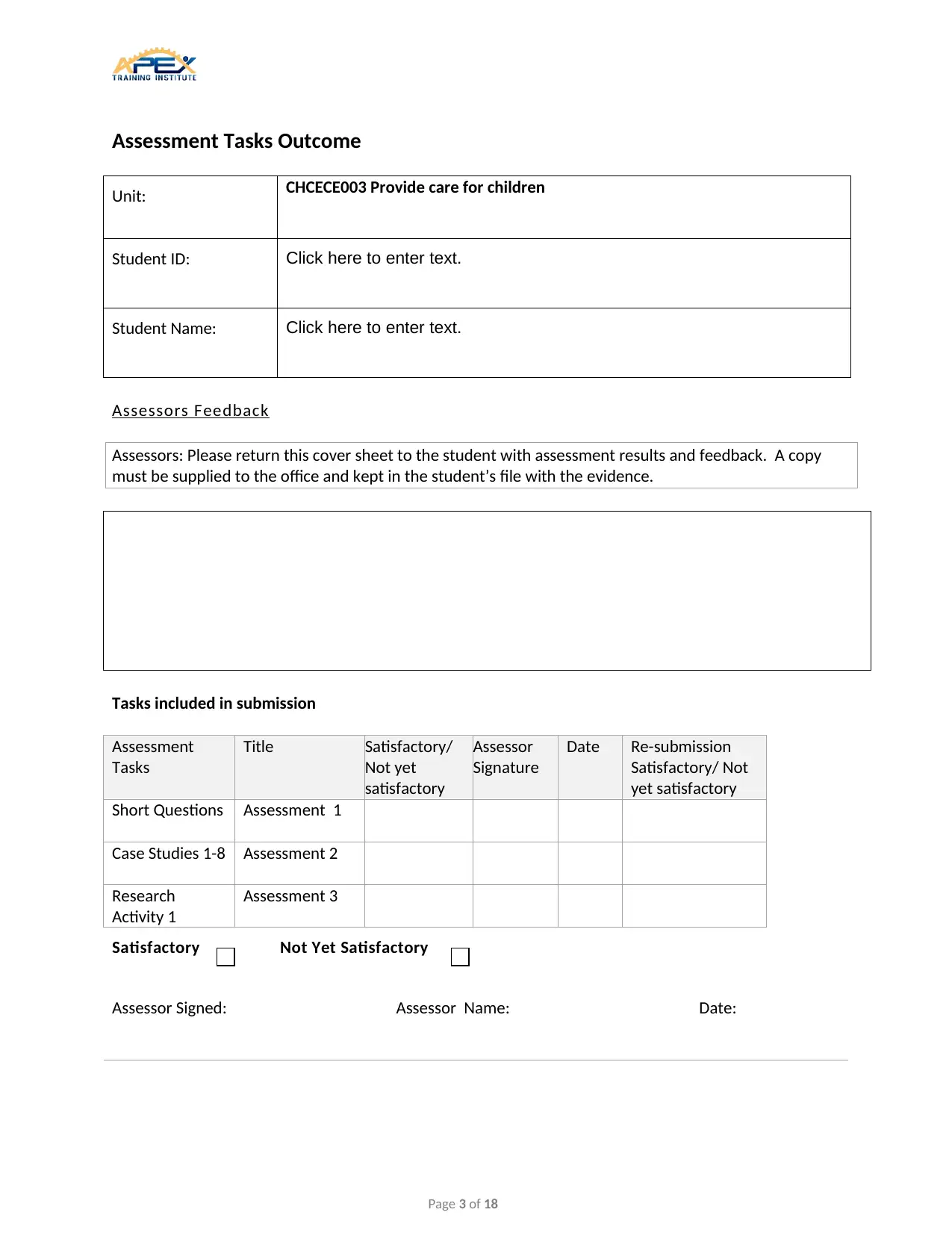
Assessment Tasks Outcome
Unit: CHCECE003 Provide care for children
Student ID: Click here to enter text.
Student Name: Click here to enter text.
Assessors Feedback
Assessors: Please return this cover sheet to the student with assessment results and feedback. A copy
must be supplied to the office and kept in the student’s file with the evidence.
Tasks included in submission
Assessment
Tasks
Title Satisfactory/
Not yet
satisfactory
Assessor
Signature
Date Re-submission
Satisfactory/ Not
yet satisfactory
Short Questions Assessment 1
Case Studies 1-8 Assessment 2
Research
Activity 1
Assessment 3
Satisfactory Not Yet Satisfactory
Assessor Signed: Assessor Name: Date:
Page 3 of 18
Unit: CHCECE003 Provide care for children
Student ID: Click here to enter text.
Student Name: Click here to enter text.
Assessors Feedback
Assessors: Please return this cover sheet to the student with assessment results and feedback. A copy
must be supplied to the office and kept in the student’s file with the evidence.
Tasks included in submission
Assessment
Tasks
Title Satisfactory/
Not yet
satisfactory
Assessor
Signature
Date Re-submission
Satisfactory/ Not
yet satisfactory
Short Questions Assessment 1
Case Studies 1-8 Assessment 2
Research
Activity 1
Assessment 3
Satisfactory Not Yet Satisfactory
Assessor Signed: Assessor Name: Date:
Page 3 of 18
⊘ This is a preview!⊘
Do you want full access?
Subscribe today to unlock all pages.

Trusted by 1+ million students worldwide

Page left intentionally blank
Page 4 of 18
Page 4 of 18
Paraphrase This Document
Need a fresh take? Get an instant paraphrase of this document with our AI Paraphraser
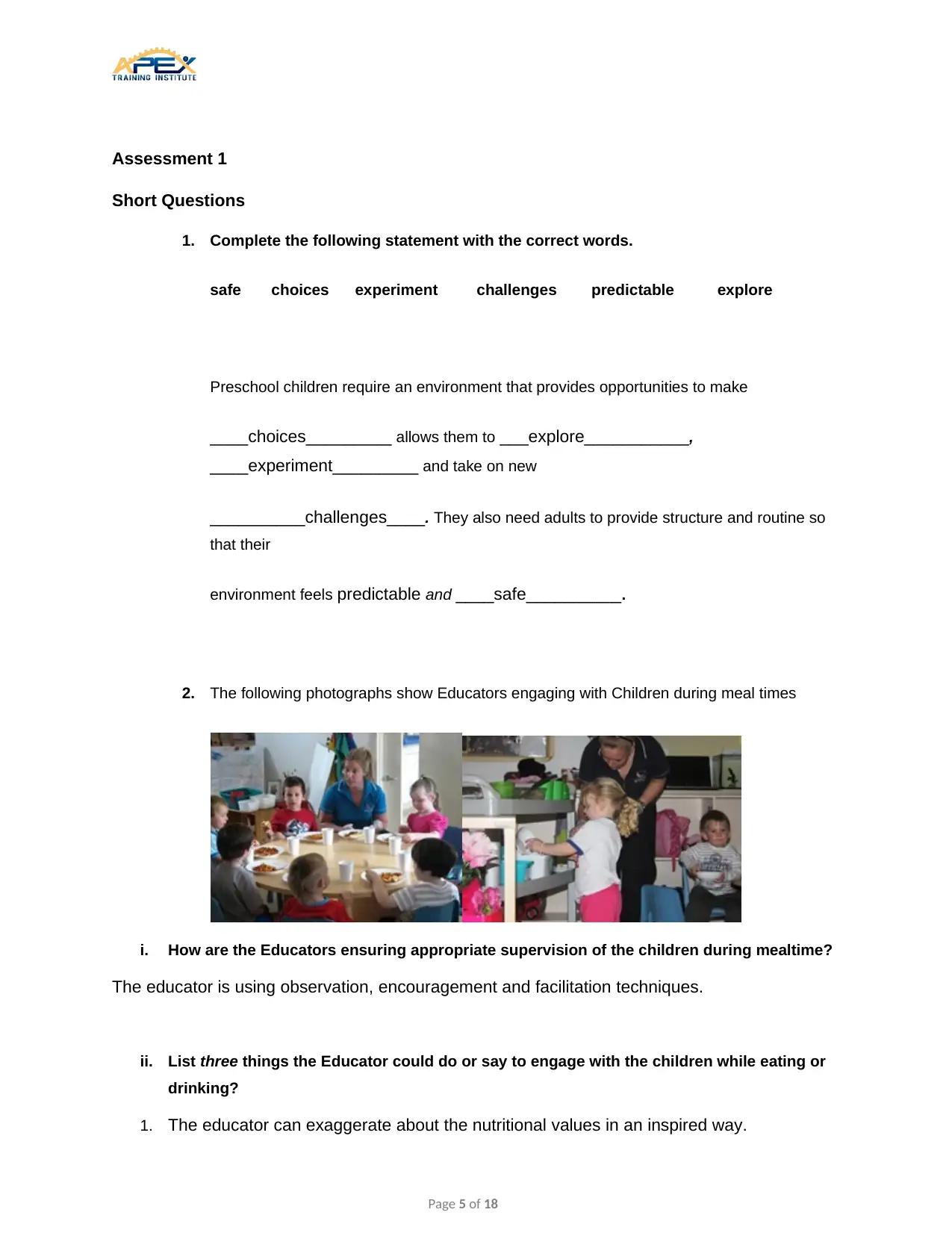
Assessment 1
Short Questions
1. Complete the following statement with the correct words.
safe choices experiment challenges predictable explore
Preschool children require an environment that provides opportunities to make
____choices_________ allows them to ___explore___________,
____experiment_________ and take on new
__________challenges____. They also need adults to provide structure and routine so
that their
environment feels predictable and ____safe__________.
2. The following photographs show Educators engaging with Children during meal times
i. How are the Educators ensuring appropriate supervision of the children during mealtime?
The educator is using observation, encouragement and facilitation techniques.
ii. List three things the Educator could do or say to engage with the children while eating or
drinking?
1. The educator can exaggerate about the nutritional values in an inspired way.
Page 5 of 18
Short Questions
1. Complete the following statement with the correct words.
safe choices experiment challenges predictable explore
Preschool children require an environment that provides opportunities to make
____choices_________ allows them to ___explore___________,
____experiment_________ and take on new
__________challenges____. They also need adults to provide structure and routine so
that their
environment feels predictable and ____safe__________.
2. The following photographs show Educators engaging with Children during meal times
i. How are the Educators ensuring appropriate supervision of the children during mealtime?
The educator is using observation, encouragement and facilitation techniques.
ii. List three things the Educator could do or say to engage with the children while eating or
drinking?
1. The educator can exaggerate about the nutritional values in an inspired way.
Page 5 of 18
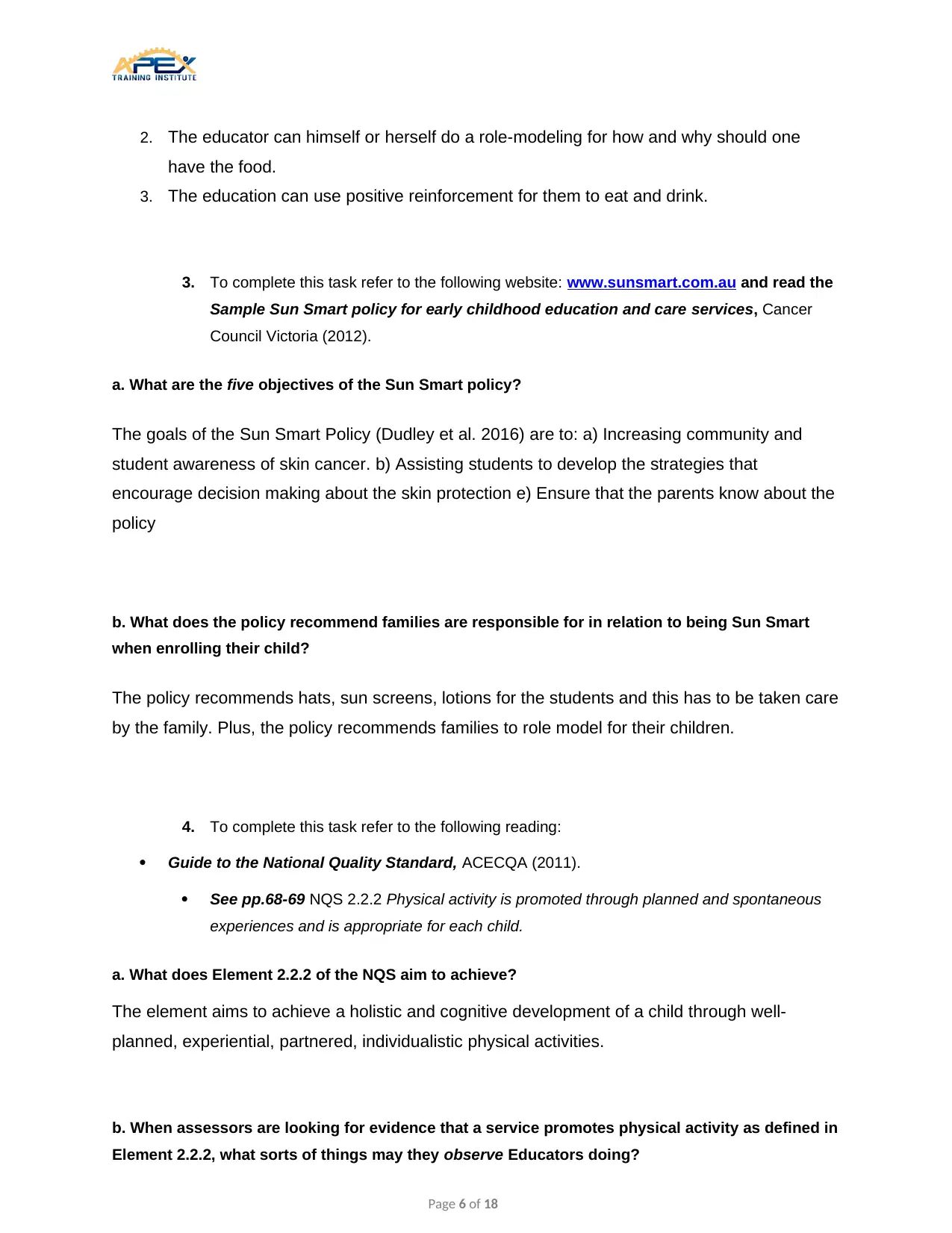
2. The educator can himself or herself do a role-modeling for how and why should one
have the food.
3. The education can use positive reinforcement for them to eat and drink.
3. To complete this task refer to the following website: www.sunsmart.com.au and read the
Sample Sun Smart policy for early childhood education and care services, Cancer
Council Victoria (2012).
a. What are the five objectives of the Sun Smart policy?
The goals of the Sun Smart Policy (Dudley et al. 2016) are to: a) Increasing community and
student awareness of skin cancer. b) Assisting students to develop the strategies that
encourage decision making about the skin protection e) Ensure that the parents know about the
policy
b. What does the policy recommend families are responsible for in relation to being Sun Smart
when enrolling their child?
The policy recommends hats, sun screens, lotions for the students and this has to be taken care
by the family. Plus, the policy recommends families to role model for their children.
4. To complete this task refer to the following reading:
Guide to the National Quality Standard, ACECQA (2011).
See pp.68-69 NQS 2.2.2 Physical activity is promoted through planned and spontaneous
experiences and is appropriate for each child.
a. What does Element 2.2.2 of the NQS aim to achieve?
The element aims to achieve a holistic and cognitive development of a child through well-
planned, experiential, partnered, individualistic physical activities.
b. When assessors are looking for evidence that a service promotes physical activity as defined in
Element 2.2.2, what sorts of things may they observe Educators doing?
Page 6 of 18
have the food.
3. The education can use positive reinforcement for them to eat and drink.
3. To complete this task refer to the following website: www.sunsmart.com.au and read the
Sample Sun Smart policy for early childhood education and care services, Cancer
Council Victoria (2012).
a. What are the five objectives of the Sun Smart policy?
The goals of the Sun Smart Policy (Dudley et al. 2016) are to: a) Increasing community and
student awareness of skin cancer. b) Assisting students to develop the strategies that
encourage decision making about the skin protection e) Ensure that the parents know about the
policy
b. What does the policy recommend families are responsible for in relation to being Sun Smart
when enrolling their child?
The policy recommends hats, sun screens, lotions for the students and this has to be taken care
by the family. Plus, the policy recommends families to role model for their children.
4. To complete this task refer to the following reading:
Guide to the National Quality Standard, ACECQA (2011).
See pp.68-69 NQS 2.2.2 Physical activity is promoted through planned and spontaneous
experiences and is appropriate for each child.
a. What does Element 2.2.2 of the NQS aim to achieve?
The element aims to achieve a holistic and cognitive development of a child through well-
planned, experiential, partnered, individualistic physical activities.
b. When assessors are looking for evidence that a service promotes physical activity as defined in
Element 2.2.2, what sorts of things may they observe Educators doing?
Page 6 of 18
⊘ This is a preview!⊘
Do you want full access?
Subscribe today to unlock all pages.

Trusted by 1+ million students worldwide
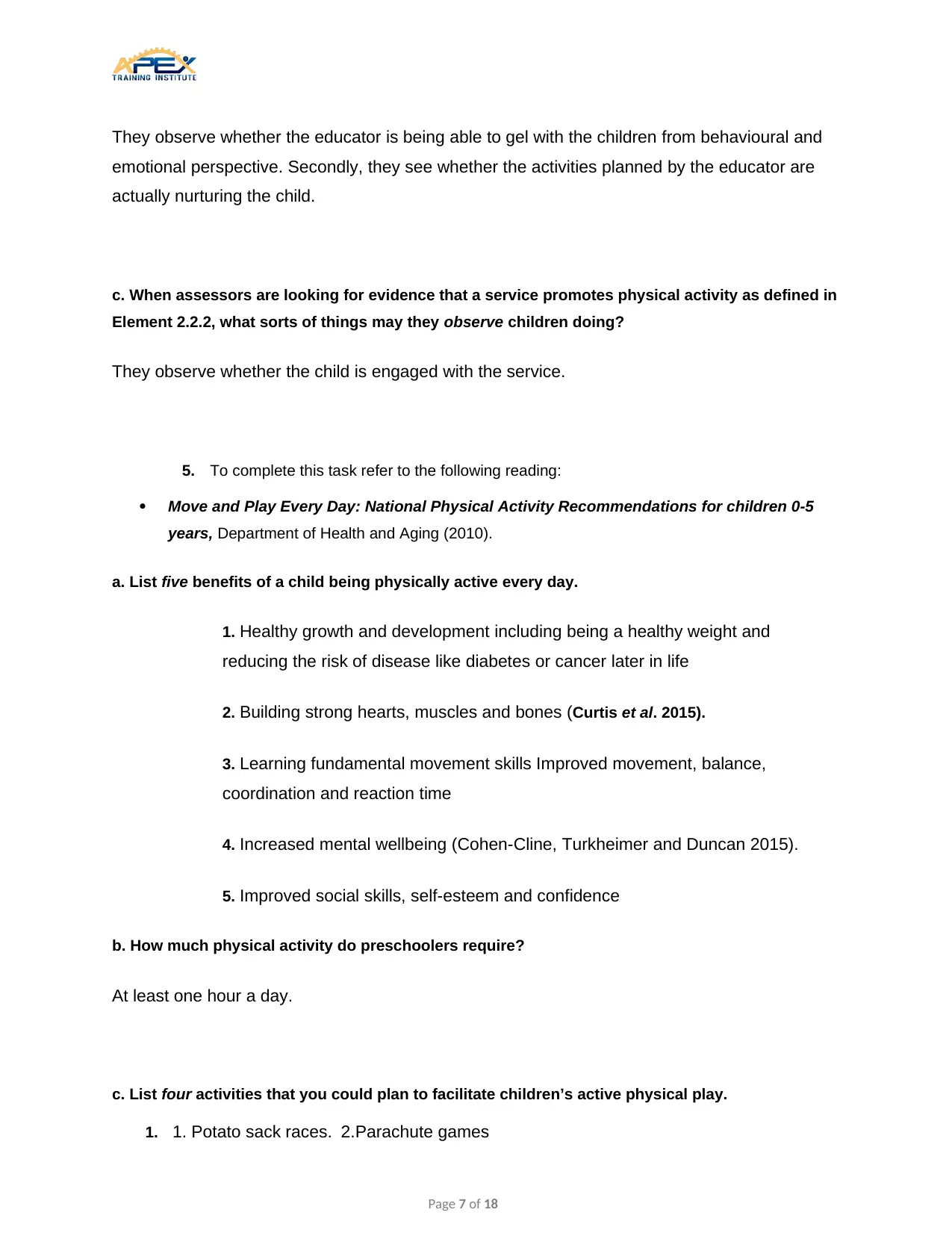
They observe whether the educator is being able to gel with the children from behavioural and
emotional perspective. Secondly, they see whether the activities planned by the educator are
actually nurturing the child.
c. When assessors are looking for evidence that a service promotes physical activity as defined in
Element 2.2.2, what sorts of things may they observe children doing?
They observe whether the child is engaged with the service.
5. To complete this task refer to the following reading:
Move and Play Every Day: National Physical Activity Recommendations for children 0-5
years, Department of Health and Aging (2010).
a. List five benefits of a child being physically active every day.
1. Healthy growth and development including being a healthy weight and
reducing the risk of disease like diabetes or cancer later in life
2. Building strong hearts, muscles and bones (Curtis et al. 2015).
3. Learning fundamental movement skills Improved movement, balance,
coordination and reaction time
4. Increased mental wellbeing (Cohen-Cline, Turkheimer and Duncan 2015).
5. Improved social skills, self-esteem and confidence
b. How much physical activity do preschoolers require?
At least one hour a day.
c. List four activities that you could plan to facilitate children’s active physical play.
1. 1. Potato sack races. 2.Parachute games
Page 7 of 18
emotional perspective. Secondly, they see whether the activities planned by the educator are
actually nurturing the child.
c. When assessors are looking for evidence that a service promotes physical activity as defined in
Element 2.2.2, what sorts of things may they observe children doing?
They observe whether the child is engaged with the service.
5. To complete this task refer to the following reading:
Move and Play Every Day: National Physical Activity Recommendations for children 0-5
years, Department of Health and Aging (2010).
a. List five benefits of a child being physically active every day.
1. Healthy growth and development including being a healthy weight and
reducing the risk of disease like diabetes or cancer later in life
2. Building strong hearts, muscles and bones (Curtis et al. 2015).
3. Learning fundamental movement skills Improved movement, balance,
coordination and reaction time
4. Increased mental wellbeing (Cohen-Cline, Turkheimer and Duncan 2015).
5. Improved social skills, self-esteem and confidence
b. How much physical activity do preschoolers require?
At least one hour a day.
c. List four activities that you could plan to facilitate children’s active physical play.
1. 1. Potato sack races. 2.Parachute games
Page 7 of 18
Paraphrase This Document
Need a fresh take? Get an instant paraphrase of this document with our AI Paraphraser
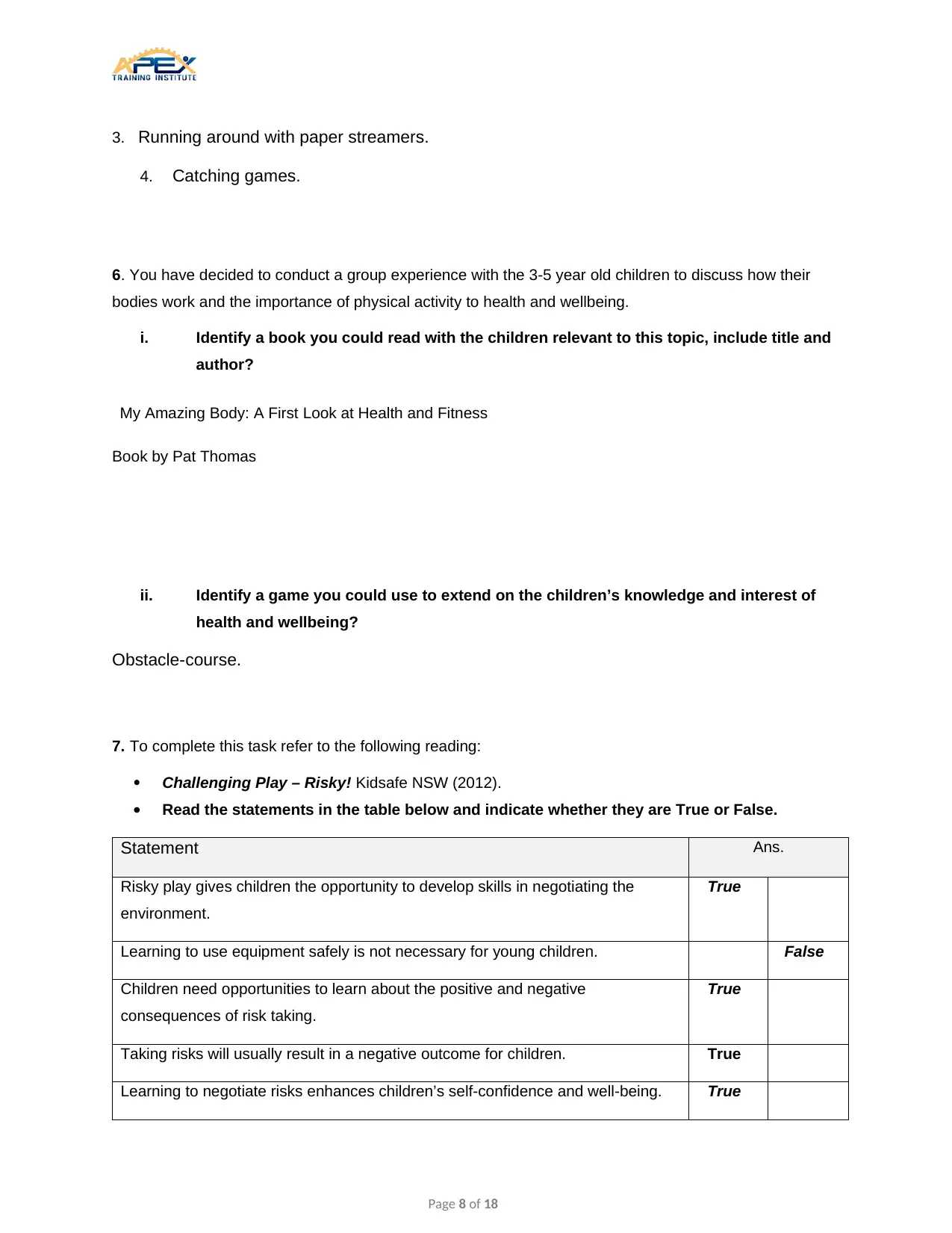
3. Running around with paper streamers.
4. Catching games.
6. You have decided to conduct a group experience with the 3-5 year old children to discuss how their
bodies work and the importance of physical activity to health and wellbeing.
i. Identify a book you could read with the children relevant to this topic, include title and
author?
My Amazing Body: A First Look at Health and Fitness
Book by Pat Thomas
ii. Identify a game you could use to extend on the children’s knowledge and interest of
health and wellbeing?
Obstacle-course.
7. To complete this task refer to the following reading:
Challenging Play – Risky! Kidsafe NSW (2012).
Read the statements in the table below and indicate whether they are True or False.
Statement Ans.
Risky play gives children the opportunity to develop skills in negotiating the
environment.
True
Learning to use equipment safely is not necessary for young children. False
Children need opportunities to learn about the positive and negative
consequences of risk taking.
True
Taking risks will usually result in a negative outcome for children. True
Learning to negotiate risks enhances children’s self-confidence and well-being. True
Page 8 of 18
4. Catching games.
6. You have decided to conduct a group experience with the 3-5 year old children to discuss how their
bodies work and the importance of physical activity to health and wellbeing.
i. Identify a book you could read with the children relevant to this topic, include title and
author?
My Amazing Body: A First Look at Health and Fitness
Book by Pat Thomas
ii. Identify a game you could use to extend on the children’s knowledge and interest of
health and wellbeing?
Obstacle-course.
7. To complete this task refer to the following reading:
Challenging Play – Risky! Kidsafe NSW (2012).
Read the statements in the table below and indicate whether they are True or False.
Statement Ans.
Risky play gives children the opportunity to develop skills in negotiating the
environment.
True
Learning to use equipment safely is not necessary for young children. False
Children need opportunities to learn about the positive and negative
consequences of risk taking.
True
Taking risks will usually result in a negative outcome for children. True
Learning to negotiate risks enhances children’s self-confidence and well-being. True
Page 8 of 18
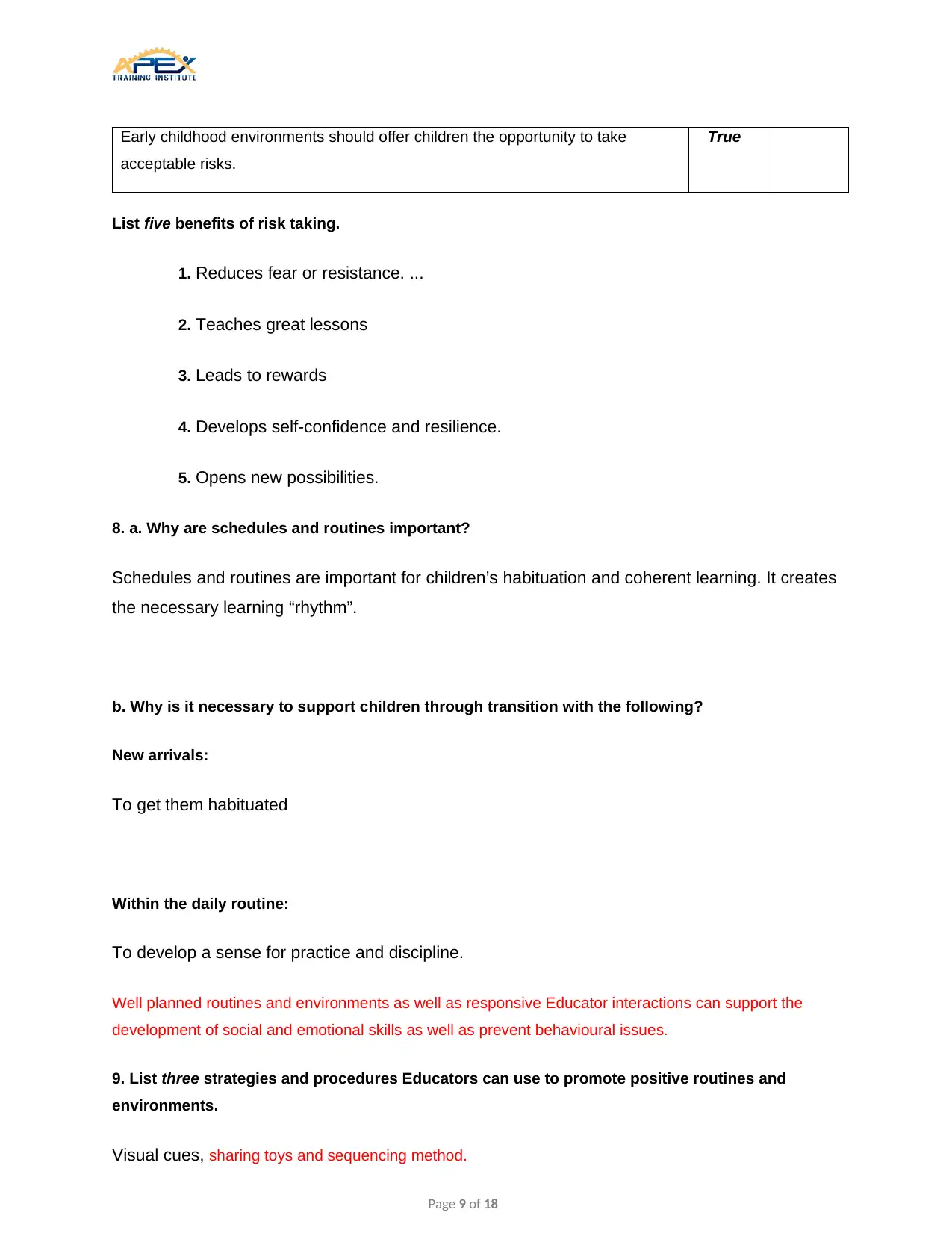
Early childhood environments should offer children the opportunity to take
acceptable risks.
True
List five benefits of risk taking.
1. Reduces fear or resistance. ...
2. Teaches great lessons
3. Leads to rewards
4. Develops self-confidence and resilience.
5. Opens new possibilities.
8. a. Why are schedules and routines important?
Schedules and routines are important for children’s habituation and coherent learning. It creates
the necessary learning “rhythm”.
b. Why is it necessary to support children through transition with the following?
New arrivals:
To get them habituated
Within the daily routine:
To develop a sense for practice and discipline.
Well planned routines and environments as well as responsive Educator interactions can support the
development of social and emotional skills as well as prevent behavioural issues.
9. List three strategies and procedures Educators can use to promote positive routines and
environments.
Visual cues, sharing toys and sequencing method.
Page 9 of 18
acceptable risks.
True
List five benefits of risk taking.
1. Reduces fear or resistance. ...
2. Teaches great lessons
3. Leads to rewards
4. Develops self-confidence and resilience.
5. Opens new possibilities.
8. a. Why are schedules and routines important?
Schedules and routines are important for children’s habituation and coherent learning. It creates
the necessary learning “rhythm”.
b. Why is it necessary to support children through transition with the following?
New arrivals:
To get them habituated
Within the daily routine:
To develop a sense for practice and discipline.
Well planned routines and environments as well as responsive Educator interactions can support the
development of social and emotional skills as well as prevent behavioural issues.
9. List three strategies and procedures Educators can use to promote positive routines and
environments.
Visual cues, sharing toys and sequencing method.
Page 9 of 18
⊘ This is a preview!⊘
Do you want full access?
Subscribe today to unlock all pages.

Trusted by 1+ million students worldwide
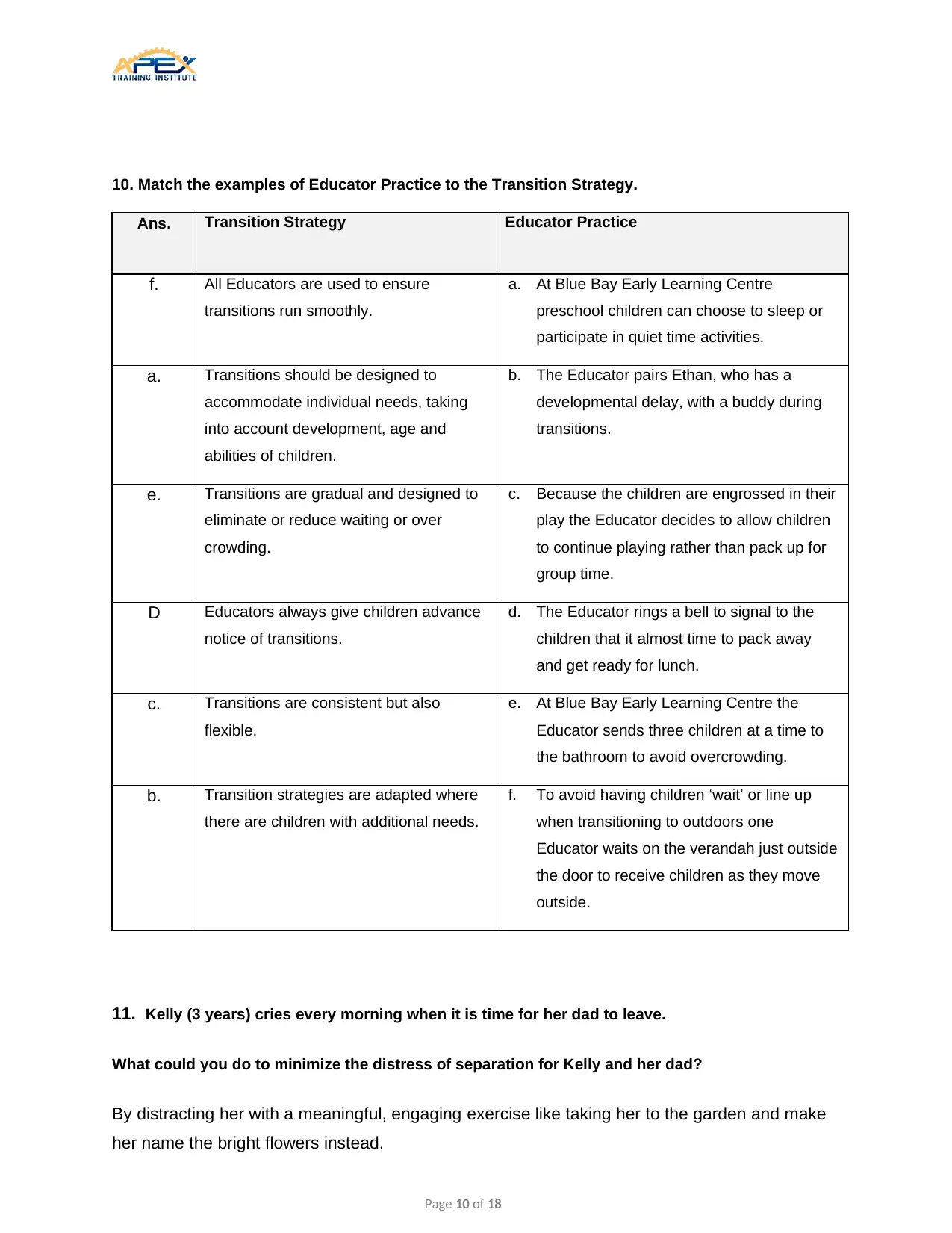
10. Match the examples of Educator Practice to the Transition Strategy.
Ans. Transition Strategy Educator Practice
f. All Educators are used to ensure
transitions run smoothly.
a. At Blue Bay Early Learning Centre
preschool children can choose to sleep or
participate in quiet time activities.
a. Transitions should be designed to
accommodate individual needs, taking
into account development, age and
abilities of children.
b. The Educator pairs Ethan, who has a
developmental delay, with a buddy during
transitions.
e. Transitions are gradual and designed to
eliminate or reduce waiting or over
crowding.
c. Because the children are engrossed in their
play the Educator decides to allow children
to continue playing rather than pack up for
group time.
D Educators always give children advance
notice of transitions.
d. The Educator rings a bell to signal to the
children that it almost time to pack away
and get ready for lunch.
c. Transitions are consistent but also
flexible.
e. At Blue Bay Early Learning Centre the
Educator sends three children at a time to
the bathroom to avoid overcrowding.
b. Transition strategies are adapted where
there are children with additional needs.
f. To avoid having children ‘wait’ or line up
when transitioning to outdoors one
Educator waits on the verandah just outside
the door to receive children as they move
outside.
11. Kelly (3 years) cries every morning when it is time for her dad to leave.
What could you do to minimize the distress of separation for Kelly and her dad?
By distracting her with a meaningful, engaging exercise like taking her to the garden and make
her name the bright flowers instead.
Page 10 of 18
Ans. Transition Strategy Educator Practice
f. All Educators are used to ensure
transitions run smoothly.
a. At Blue Bay Early Learning Centre
preschool children can choose to sleep or
participate in quiet time activities.
a. Transitions should be designed to
accommodate individual needs, taking
into account development, age and
abilities of children.
b. The Educator pairs Ethan, who has a
developmental delay, with a buddy during
transitions.
e. Transitions are gradual and designed to
eliminate or reduce waiting or over
crowding.
c. Because the children are engrossed in their
play the Educator decides to allow children
to continue playing rather than pack up for
group time.
D Educators always give children advance
notice of transitions.
d. The Educator rings a bell to signal to the
children that it almost time to pack away
and get ready for lunch.
c. Transitions are consistent but also
flexible.
e. At Blue Bay Early Learning Centre the
Educator sends three children at a time to
the bathroom to avoid overcrowding.
b. Transition strategies are adapted where
there are children with additional needs.
f. To avoid having children ‘wait’ or line up
when transitioning to outdoors one
Educator waits on the verandah just outside
the door to receive children as they move
outside.
11. Kelly (3 years) cries every morning when it is time for her dad to leave.
What could you do to minimize the distress of separation for Kelly and her dad?
By distracting her with a meaningful, engaging exercise like taking her to the garden and make
her name the bright flowers instead.
Page 10 of 18
Paraphrase This Document
Need a fresh take? Get an instant paraphrase of this document with our AI Paraphraser
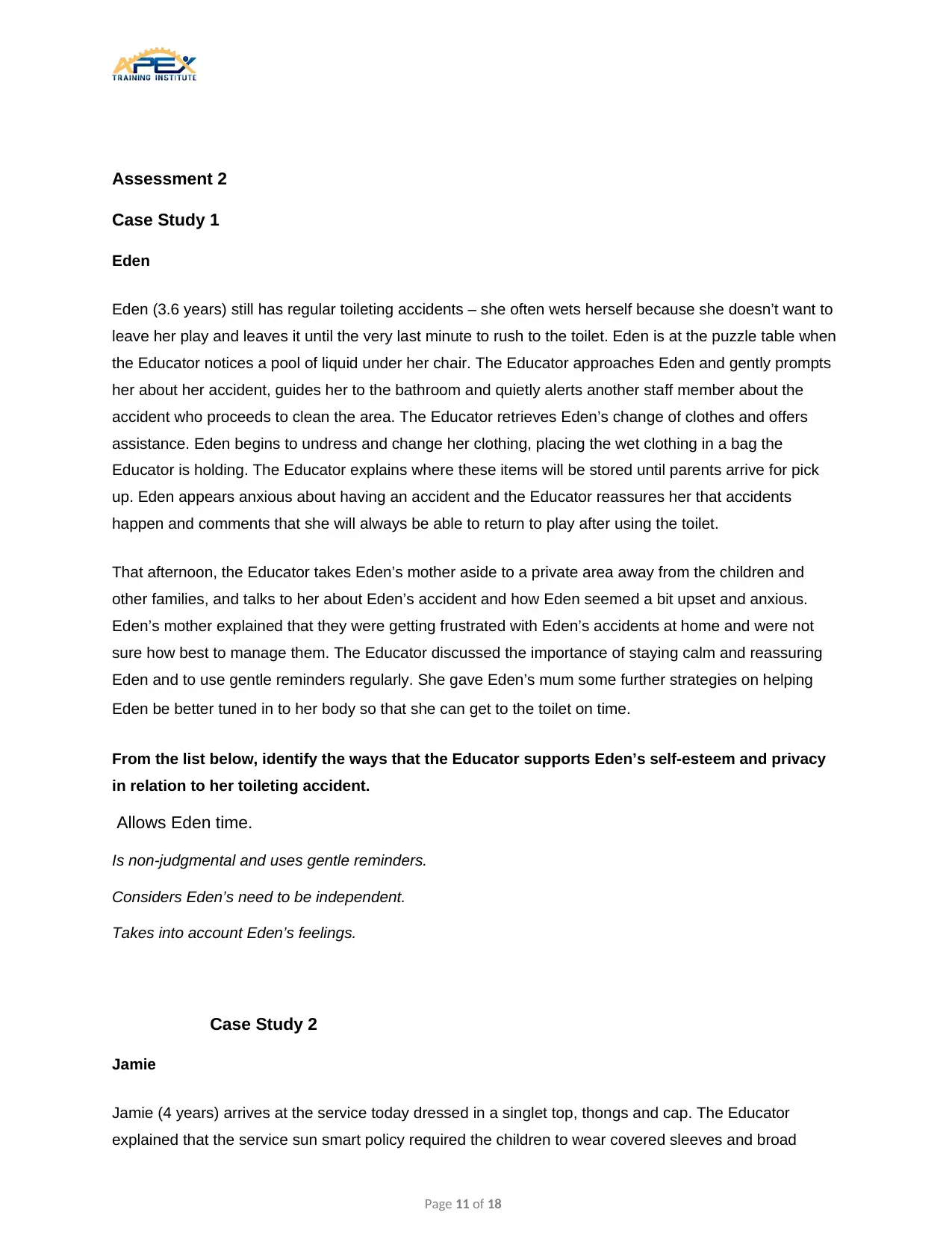
Assessment 2
Case Study 1
Eden
Eden (3.6 years) still has regular toileting accidents – she often wets herself because she doesn’t want to
leave her play and leaves it until the very last minute to rush to the toilet. Eden is at the puzzle table when
the Educator notices a pool of liquid under her chair. The Educator approaches Eden and gently prompts
her about her accident, guides her to the bathroom and quietly alerts another staff member about the
accident who proceeds to clean the area. The Educator retrieves Eden’s change of clothes and offers
assistance. Eden begins to undress and change her clothing, placing the wet clothing in a bag the
Educator is holding. The Educator explains where these items will be stored until parents arrive for pick
up. Eden appears anxious about having an accident and the Educator reassures her that accidents
happen and comments that she will always be able to return to play after using the toilet.
That afternoon, the Educator takes Eden’s mother aside to a private area away from the children and
other families, and talks to her about Eden’s accident and how Eden seemed a bit upset and anxious.
Eden’s mother explained that they were getting frustrated with Eden’s accidents at home and were not
sure how best to manage them. The Educator discussed the importance of staying calm and reassuring
Eden and to use gentle reminders regularly. She gave Eden’s mum some further strategies on helping
Eden be better tuned in to her body so that she can get to the toilet on time.
From the list below, identify the ways that the Educator supports Eden’s self-esteem and privacy
in relation to her toileting accident.
Allows Eden time.
Is non-judgmental and uses gentle reminders.
Considers Eden’s need to be independent.
Takes into account Eden’s feelings.
Case Study 2
Jamie
Jamie (4 years) arrives at the service today dressed in a singlet top, thongs and cap. The Educator
explained that the service sun smart policy required the children to wear covered sleeves and broad
Page 11 of 18
Case Study 1
Eden
Eden (3.6 years) still has regular toileting accidents – she often wets herself because she doesn’t want to
leave her play and leaves it until the very last minute to rush to the toilet. Eden is at the puzzle table when
the Educator notices a pool of liquid under her chair. The Educator approaches Eden and gently prompts
her about her accident, guides her to the bathroom and quietly alerts another staff member about the
accident who proceeds to clean the area. The Educator retrieves Eden’s change of clothes and offers
assistance. Eden begins to undress and change her clothing, placing the wet clothing in a bag the
Educator is holding. The Educator explains where these items will be stored until parents arrive for pick
up. Eden appears anxious about having an accident and the Educator reassures her that accidents
happen and comments that she will always be able to return to play after using the toilet.
That afternoon, the Educator takes Eden’s mother aside to a private area away from the children and
other families, and talks to her about Eden’s accident and how Eden seemed a bit upset and anxious.
Eden’s mother explained that they were getting frustrated with Eden’s accidents at home and were not
sure how best to manage them. The Educator discussed the importance of staying calm and reassuring
Eden and to use gentle reminders regularly. She gave Eden’s mum some further strategies on helping
Eden be better tuned in to her body so that she can get to the toilet on time.
From the list below, identify the ways that the Educator supports Eden’s self-esteem and privacy
in relation to her toileting accident.
Allows Eden time.
Is non-judgmental and uses gentle reminders.
Considers Eden’s need to be independent.
Takes into account Eden’s feelings.
Case Study 2
Jamie
Jamie (4 years) arrives at the service today dressed in a singlet top, thongs and cap. The Educator
explained that the service sun smart policy required the children to wear covered sleeves and broad
Page 11 of 18
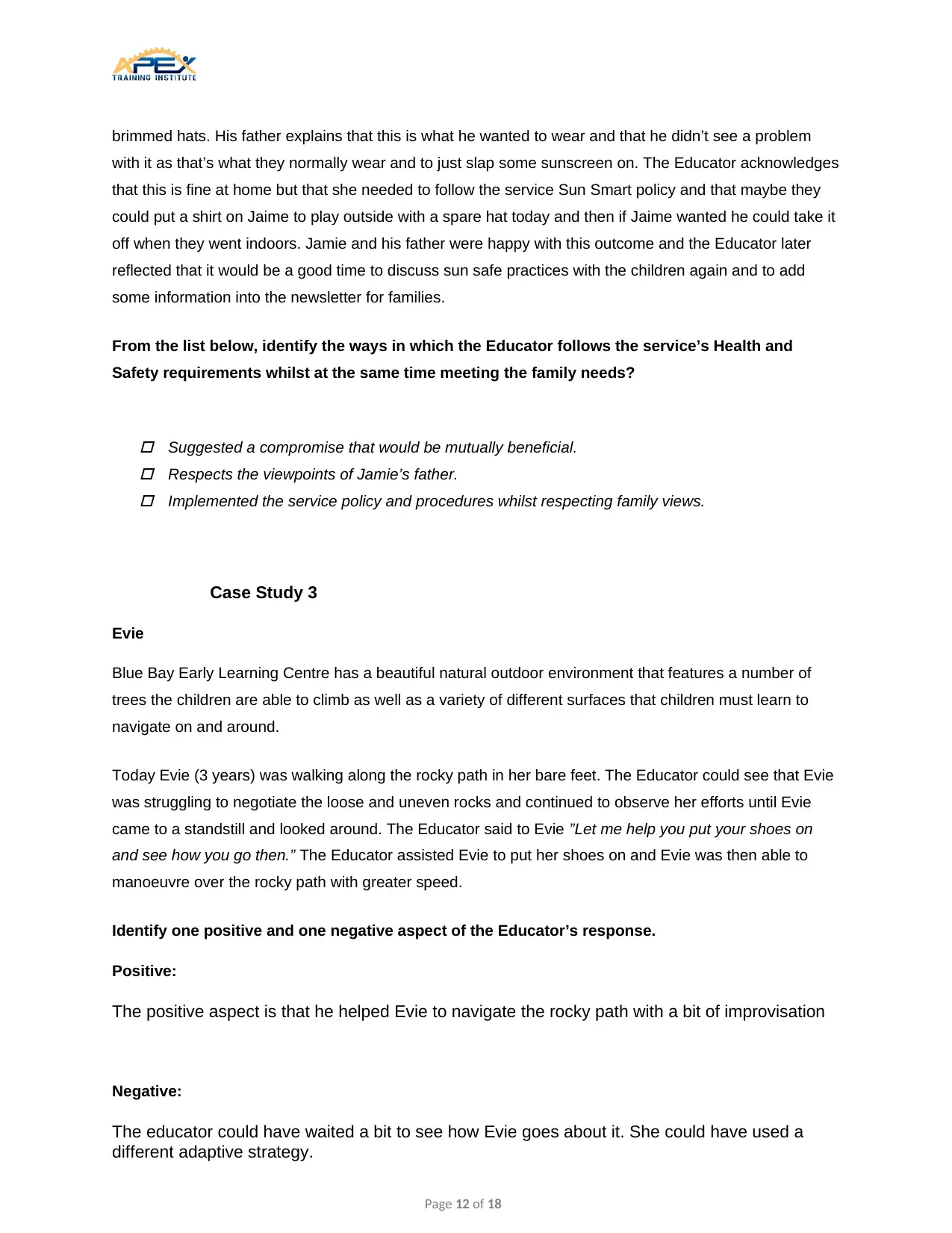
brimmed hats. His father explains that this is what he wanted to wear and that he didn’t see a problem
with it as that’s what they normally wear and to just slap some sunscreen on. The Educator acknowledges
that this is fine at home but that she needed to follow the service Sun Smart policy and that maybe they
could put a shirt on Jaime to play outside with a spare hat today and then if Jaime wanted he could take it
off when they went indoors. Jamie and his father were happy with this outcome and the Educator later
reflected that it would be a good time to discuss sun safe practices with the children again and to add
some information into the newsletter for families.
From the list below, identify the ways in which the Educator follows the service’s Health and
Safety requirements whilst at the same time meeting the family needs?
o Suggested a compromise that would be mutually beneficial.
o Respects the viewpoints of Jamie’s father.
o Implemented the service policy and procedures whilst respecting family views.
Case Study 3
Evie
Blue Bay Early Learning Centre has a beautiful natural outdoor environment that features a number of
trees the children are able to climb as well as a variety of different surfaces that children must learn to
navigate on and around.
Today Evie (3 years) was walking along the rocky path in her bare feet. The Educator could see that Evie
was struggling to negotiate the loose and uneven rocks and continued to observe her efforts until Evie
came to a standstill and looked around. The Educator said to Evie ”Let me help you put your shoes on
and see how you go then.” The Educator assisted Evie to put her shoes on and Evie was then able to
manoeuvre over the rocky path with greater speed.
Identify one positive and one negative aspect of the Educator’s response.
Positive:
The positive aspect is that he helped Evie to navigate the rocky path with a bit of improvisation
Negative:
The educator could have waited a bit to see how Evie goes about it. She could have used a
different adaptive strategy.
Page 12 of 18
with it as that’s what they normally wear and to just slap some sunscreen on. The Educator acknowledges
that this is fine at home but that she needed to follow the service Sun Smart policy and that maybe they
could put a shirt on Jaime to play outside with a spare hat today and then if Jaime wanted he could take it
off when they went indoors. Jamie and his father were happy with this outcome and the Educator later
reflected that it would be a good time to discuss sun safe practices with the children again and to add
some information into the newsletter for families.
From the list below, identify the ways in which the Educator follows the service’s Health and
Safety requirements whilst at the same time meeting the family needs?
o Suggested a compromise that would be mutually beneficial.
o Respects the viewpoints of Jamie’s father.
o Implemented the service policy and procedures whilst respecting family views.
Case Study 3
Evie
Blue Bay Early Learning Centre has a beautiful natural outdoor environment that features a number of
trees the children are able to climb as well as a variety of different surfaces that children must learn to
navigate on and around.
Today Evie (3 years) was walking along the rocky path in her bare feet. The Educator could see that Evie
was struggling to negotiate the loose and uneven rocks and continued to observe her efforts until Evie
came to a standstill and looked around. The Educator said to Evie ”Let me help you put your shoes on
and see how you go then.” The Educator assisted Evie to put her shoes on and Evie was then able to
manoeuvre over the rocky path with greater speed.
Identify one positive and one negative aspect of the Educator’s response.
Positive:
The positive aspect is that he helped Evie to navigate the rocky path with a bit of improvisation
Negative:
The educator could have waited a bit to see how Evie goes about it. She could have used a
different adaptive strategy.
Page 12 of 18
⊘ This is a preview!⊘
Do you want full access?
Subscribe today to unlock all pages.

Trusted by 1+ million students worldwide
1 out of 18
Related Documents
Your All-in-One AI-Powered Toolkit for Academic Success.
+13062052269
info@desklib.com
Available 24*7 on WhatsApp / Email
![[object Object]](/_next/static/media/star-bottom.7253800d.svg)
Unlock your academic potential
Copyright © 2020–2025 A2Z Services. All Rights Reserved. Developed and managed by ZUCOL.





